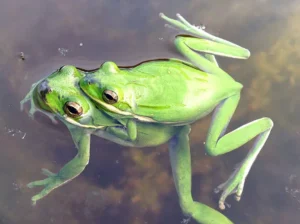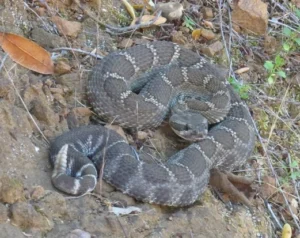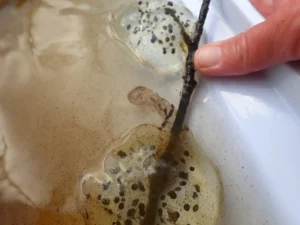Salamanders are often mistaken for reptiles. With their long bodies, four legs, and lizard-like shape, it’s easy to understand why. They are sometimes seen in the same areas as snakes, turtles, or lizards, which adds to the confusion. But are salamanders really reptiles?
No, salamanders are not reptiles. They are amphibians, which is a completely different class of animals with their own set of unique traits and life stages. Although salamanders may look similar to reptiles at first glance, they are biologically and evolutionarily distinct.
Their skin, life cycle, and the way they breathe all separate them from reptiles. Knowing the differences between amphibians and reptiles helps explain where salamanders really belong.
What Makes Amphibians and Reptiles Different?
To understand why salamanders are not reptiles, it helps to look at how animals are grouped. Salamanders and reptiles are both vertebrates, which means they have backbones.
But they come from two different animal classes: Amphibia and Reptilia.
These two classes are not just names, they tell us how these animals live, breathe, grow, and survive.
What Are Amphibians?
Amphibians are cold-blooded animals that usually live part of their life in water and part on land. Their name comes from Greek and means “double life.”

Frogs, toads, newts, and salamanders are all amphibians. They have soft, moist skin and most go through metamorphosis, a process where young animals change form as they grow into adults.
Here are some key traits of amphibians:
- Their skin is moist and helps them breathe.
- They lay jelly-like eggs in water or damp areas.
- Their young usually start out with gills and later grow lungs.
- They need water or moisture to survive and reproduce.
What Are Reptiles?
Reptiles are also cold-blooded, but they are better suited to dry life on land. Reptiles include snakes, lizards, turtles, and crocodiles.

Unlike amphibians, reptiles do not need water to breed. Their eggs have protective shells, and their skin is dry and covered in scales.
Reptiles share these traits:
- They have dry, scaly skin made of keratin.
- They lay leathery or hard-shelled eggs on land.
- They breathe with lungs throughout their lives.
- They hatch from eggs as fully formed young, not as larvae.
Why Salamanders Are Amphibians, Not Reptiles
Even though they might look like lizards, salamanders belong with frogs and newts, not with snakes or turtles. There are several important reasons why.
1. Skin Type and Function
Salamanders have thin, moist skin that must stay wet. Their skin plays a role in breathing, this is called cutaneous respiration, which means they can absorb oxygen and release carbon dioxide through their skin. This only works if their skin stays damp.
Reptiles, on the other hand, have dry, scaly skin. These scales protect them from drying out and injury. But reptiles do not use their skin to breathe. They rely fully on their lungs.
2. Breathing Systems
Most salamanders start life with gills, which let them breathe underwater. As they grow, many develop lungs or continue breathing through their skin. Some species, like the axolotl, keep their gills their whole lives.
Reptiles are very different. They have lungs from the moment they hatch, and they do not use gills at any stage. Even as hatchlings, reptiles breathe air with lungs, just like they do as adults.
3. Life Cycle and Metamorphosis
Salamanders begin life as soft, jelly-like eggs laid in water.
The eggs hatch into larvae with gills and no legs. Over time, the larvae go through metamorphosis, growing legs, losing gills, and developing lungs.

Reptiles don’t go through metamorphosis. Their young hatch from eggs already shaped like adults. A baby turtle or lizard is just a smaller version of the adult.
4. Reproduction and Eggs
Salamanders lay their eggs in water or very damp places. The eggs have no shell and must stay moist. Inside the eggs, the larvae develop and then hatch to live in water until they transform.

Reptile eggs are quite different. They are laid on land and have a protective outer layer. This shell helps prevent the egg from drying out. The young reptiles develop inside and hatch ready to live on land.
5. Habitat and Water Needs
Salamanders can’t stay away from water for too long. Even those that live mostly on land need damp places to survive.
They often hide under logs, rocks, or leaves to keep their skin moist.
Reptiles are more flexible. Many live in dry places like deserts or rocky hills. Their scaly skin keeps water in and helps them stay alive in dry weather.
Scientific Classification of Salamanders
Scientists group living things based on their body structures, behavior, and DNA. These groups are called taxonomic classes, and salamanders fall into the class Amphibia.
Within that class, salamanders belong to the order Caudata (also called Urodela). These animals all have long tails, moist skin, and four legs of similar size.
Reptiles belong to the class Reptilia. This class includes snakes and lizards (Squamata), turtles (Testudines), and crocodilians (Crocodylia).
Salamanders and reptiles split from a common ancestor over 300 million years ago. Since then, they have developed along very different paths.
Conclusion
No, salamanders are not reptiles. They are amphibians, a unique group of animals with soft skin, a life cycle that includes metamorphosis, and special ways of breathing and reproducing.
Even though salamanders may look like lizards or live in similar places, their biology tells a different story.
Their smooth skin, gilled larvae, and deep ties to water show clearly that they belong to a different class of animals.
Hi, my name is Ezra Mushala, i have been interested animals all my life. I am the main author and editor here at snakeinformer.com.

